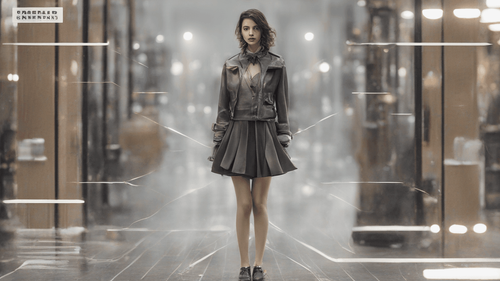
Introduction: Unveiling the Future of Artistic Creation
Art and technology have always danced in a delicate balance, giving birth to innovations that shape human culture. In this digital age, the fusion of artificial intelligence (AI) with the realm of art has sparked a revolution like no other. Enter the captivating world of AI art rendering, where machines collaborate with human creativity to produce mesmerizing visual compositions that challenge conventional boundaries. From reimagining classical masterpieces to forging entirely new artistic landscapes, AI art rendering is an avant-garde force that holds the potential to redefine how we perceive and create art.
AI Art Rendering: Illuminating the Essence
What is AI Art Rendering?
AI art rendering is a groundbreaking technology that employs artificial intelligence algorithms to generate, manipulate, or enhance visual artworks. By mimicking human artistic processes, AI algorithms analyze vast amounts of data and patterns, enabling them to create intricate and compelling visual compositions. Through this revolutionary approach, artists and creators can transcend traditional limitations, unlocking new realms of imagination and expression.
How Does AI Art Rendering Work?
At its core, AI art rendering operates through neural networks, which are inspired by the human brain's interconnected structure. These networks consist of layers of interconnected nodes that process and interpret data. In the context of art rendering, these networks are trained on a diverse array of artistic styles, techniques, and historical references. When fed with input data, such as an existing artwork or a set of parameters, the neural networks apply their learned knowledge to generate an entirely new piece of art that adheres to the specified style or characteristics.
The Evolution of AI Art Rendering: From GANs to Style Transfer
The Rise of Generative Adversarial Networks (GANs)
Generative Adversarial Networks, or GANs, are the driving force behind many AI art rendering breakthroughs. GANs consist of two neural networks—the generator and the discriminator—that collaborate in a creative dance. The generator creates art, while the discriminator evaluates it for authenticity. This dynamic interplay leads to a continuous refinement of the generated artwork, ultimately producing stunning pieces that challenge the boundaries of human imagination.
Style Transfer: Infusing Artistic DNA
Style transfer, another facet of AI art rendering, involves applying the stylistic elements of one artwork onto another. This process, driven by deep neural networks, allows artists to meld distinct visual aesthetics. Imagine the surreal fusion of Van Gogh's vibrant strokes with Picasso's cubist geometry—a harmonious collision of artistic DNA that redefines the concept of originality.
Revolutionizing Creative Expression: The AI Art Rendering Landscape
Unlocking Imagination with Infinite Possibilities
AI art rendering liberates artists from the confines of traditional tools and techniques. It offers a digital canvas where ideas can be explored, dismantled, and reconstructed without hesitation. This newfound freedom enables artists to experiment with styles, genres, and compositions, fostering a creative environment that thrives on innovation.
The Elevation of Collaboration: Man and Machine Unite
AI art rendering isn't about replacing human artists—it's about collaboration. Machines don't possess emotions, but they can perceive patterns and execute complex algorithms. Human artists infuse their works with emotions, experiences, and narratives. By merging these two realms, a symphony of creativity emerges, birthing artworks that resonate deeply with audiences.
AI Art Rendering in Practice: Showcasing Masterpieces
The Artistic Renovation: Recreating Classics
AI art rendering has breathed new life into classic artworks, introducing fresh perspectives and contemporary reinterpretations. For instance, algorithms can reimagine Leonardo da Vinci's "Mona Lisa" in the style of Salvador Dalí, bridging temporal gaps and transcending artistic epochs.
Abstract Dreams Materialized: From Concept to Canvas
Abstract art, with its fluidity and lack of strict form, aligns seamlessly with the nature of AI art rendering. Algorithms can translate abstract concepts into tangible visual representations, offering a glimpse into the minds of artists as they wrestle with intangible ideas and emotions.
AI Art Rendering FAQs: Demystified
Can AI Replace Human Creativity?
While AI can replicate patterns and styles, true creativity stems from human experiences, emotions, and intellect. AI complements human creativity, offering a palette of tools and inspirations to amplify artistic expression.
Is AI Art Original?
AI-generated art is unique in its own right, stemming from a blend of learned techniques and algorithms. However, the essence of originality remains tied to the human intent and conceptualization driving the AI's artistic endeavors.
What Challenges Does AI Art Rendering Face?
AI art rendering faces challenges such as avoiding biases encoded in algorithms, achieving a balance between imitation and innovation, and addressing ethical concerns related to authorship and authenticity.
How Does AI Impact Art Appreciation?
AI challenges our notions of creativity, authorship, and the creative process. It invites viewers to engage in thoughtful discussions about the evolving landscape of art and the symbiotic relationship between human and machine.
Is AI Art Rendering Accessible to All?
As technology advances, AI art rendering tools are becoming more accessible to artists across different skill levels. Novices and experts alike can harness the power of AI to explore new artistic frontiers.
What Does the Future Hold for AI Art Rendering?
The future of AI art rendering is a tapestry of endless possibilities. As technology evolves, we can anticipate even more sophisticated algorithms, seamless integrations with traditional artistic practices, and a richer, more diverse artistic landscape.
Conclusion: A Harmonious Overture of Creativity and Innovation
In the mesmerizing realm of AI art rendering, technology and creativity harmonize to orchestrate a symphony of innovation. This revolutionary juncture isn't about replacing human artists—it's about amplifying their voices, catalyzing their imaginations, and extending the horizons of what's artistically possible. As AI continues to evolve, so too does the potential to forge new artistic dimensions, challenge preconceptions, and inspire generations to come. The journey has just begun, and the canvas of AI art rendering stretches endlessly before us—a canvas where human ingenuity and machine intelligence paint the future of artistic expression.